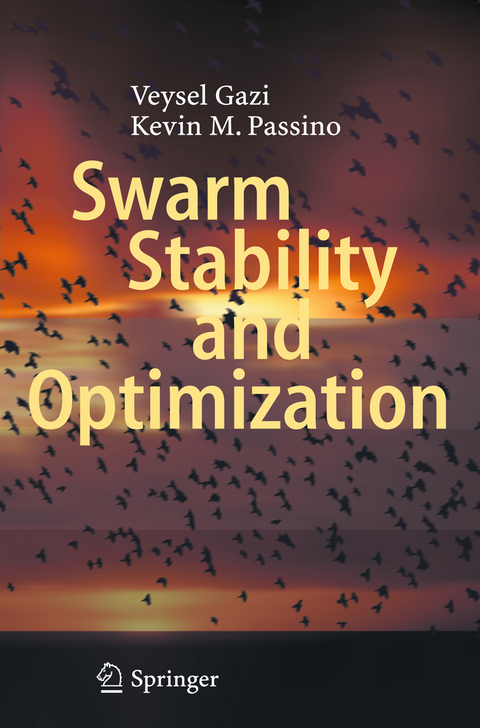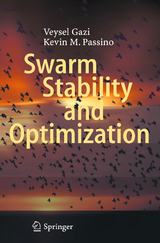Swarm Stability and Optimization
Springer Berlin (Verlag)
978-3-642-18040-8 (ISBN)
Swarming species such as flocks of birds or schools of fish exhibit
fascinating collective behaviors during migration and predator
avoidance. Similarly, engineered multi-agent dynamic systems such as groups of autonomous ground, underwater, or air vehicles ("vehicle swarms") exhibit sophisticated collective behaviors while maneuvering.
In this book we show how to model and control a wide range of such
multi-agent dynamic systems and analyze their collective behavior
using both stability theoretic and simulation-based approaches. In
particular, we investigate problems such as group aggregation, social
foraging, formation control, swarm tracking, distributed agreement,
and engineering optimization inspired by swarm behavior.
Part I Basic Principles
1 Introduction
2 Swarm Coordination and Control Problems
2.1 Aggregation
2.2 Social Foraging
2.3 Formation Control
2.4 Swarm Tracking
2.5 Distributed Agreement
Part II Continuous Time Swarms
3 Swarms of Single Integrator Agents
3.1 Single Integrator Agent Model
3.2 Aggregation
3.2.1 Potential Function Design
3.2.2 Analysis of Swarm Motion
3.2.3 Swarm Cohesion Analysis
3.2.4 Individuals with Finite Body Size
3.2.5 Simulation Examples
3.3 Social Foraging
3.3.1 Introduction
3.3.2 Swarm Cohesion Analysis
3.3.3 Swarm Motion in Various Resource Profiles
3.3.4 Analysis of Individual Behavior in a Cohesive Swarm
3.3.5 Simulation Examples
3.4 Formation Control
3.4.1 Simulation Examples
3.5 Swarm Tracking
3.5.1 Simulation Examples
3.6 Further Issues
3.6.1 General Neighborhood Topology
3.6.2 Non-Reciprocal Agent Interactions
3.6.3 For Further Reading
4 Swarms of Double Integrator Agents
4.1 Double IntegratorModel
4.2 Stability Analysis of Swarm Cohesion Properties
4.2.1 Controls and Error Dynamics
4.2.2 Cohesive Social Foraging with Noise1
4.2.3 Special Case: Identical Agents
4.3 Stability Analysis of Swarm Trajectory Following
4.4 Simulation Examples
4.4.1 No-Noise Case
4.4.2 Noise Case
4.5 Further Issues
4.5.1 Extensions and Generalizations
4.5.2 For Further Reading
5 Swarms of Fully Actuated Agents with Model Uncertainty
5.1 Fully Actuated Agent Model with Uncertainty
5.2 Controller Development
5.2.1 Aggregation, Foraging, and Formation Control
5.2.2 Swarm Tracking
5.3 Potential Functions and Bounds
5.3.1 Aggregation
5.3.2 Social Foraging
5.3.3 Formation Control
5.3.4 Swarm Tracking
5.4 Simulation Examples
5.4.1 Aggregation
5.4.2 Social Foraging
5.4.3 Formation Control
5.4.4 Swarm Tracking
5.5 Further Issues
5.5.1 Extensions and Generalizations
5.5.2 For Further Reading
6 Swarms of Non-Holonomic Unicycle Agents with Model Uncertainty
6.1 Non-Holonomic Unicycle Agent Model with Uncertainty
6.2 Controller Development
6.3 Potential Functions and Bounds
6.4 Simulation Examples
6.5 Further Issues
7 Formation Control using Nonlinear Servomechanism
7.1 General Non-Linear Agent Model
7.2 Controller Development
7.2.1 Full Information Controller
7.2.2 Error Feedback Controller .
7.3 Formation Reconfiguration
7.3.1 Expansion/Contraction.
7.3.2 Rotation
7.3.3 Topology Change
7.4 Illustrative Examples
7.5 Further Issues
Part III Discrete Time Swarms
8 Asynchronous Distributed Agreement in Discrete Time Swarms
8.1 Model of the System
8.2 System Under Total Synchronism
8.3 Asynchronous System
8.4 Simulation Examples
8.5 Further Issues
9 Formation Control with Potential Functions and Newtons Iteration
9.1 Model of the System
9.2 Controller Development
9.3 Simulation Examples
9.4 Further Issues
10 Orientation Agreement in Swarms of Self-Propelled Particles
10.1 Self-Propelled Particle Agent Model
10.2 Strategies for Orientation Agreement
10.3 Turn Angle Restrictions
10.4 Simulation Examples
10.5 Further Issues
Part IV Swarm Based OptimizationMethods
11 Biomimicry of Bacteria Foraging for Optimization
11.1 Bacterial Foraging by E. coli
11.1.1 Swimming and Tumbling
11.1.2 Chemotaxis and Climbing Nutrient Gradients
11.1.3 Underlying Sensing and Decision-Making Mechanisms
11.1.4 Elimination and Dispersal Events
11.2 E. coli Bacterial Foraging for Optimization
11.2.1 An Optimization Model for E. coli Bacterial Foraging
11.2.2 Bacterial Foraging Optimization Algorithm (BFOA)
11.2.3 Guidelines for Algorithm Parameter Choices
11.2.4 Relations to the Genetic Algorithm
11.3 Example: Function Optimization via E. coli Foraging
11.3.1 Nutrient Hill-Climbing: No Swarming
11.3.2 Swarming Effects
11.4 Further Issues
11.4.1 Extensions and Generalizations
11.4.2 For Further Reading
12 Particle Swarm Optimization
12.1 Synchronous PSO Algorithm
12.2 Decentralized Asynchronous PSO Formulation
12.3 Dyn
From the reviews:
"The book is intended as a textbook for a course on multiagent dynamic systems; as a supplementary book in courses on nonlinear control systems, optimization, or discrete-time control systems; or as a reference book for graduate students, researchers, and engineers performing studies or implementation work in the area of multiagent dynamic systems." (IEEE Control Systems Magazine, Vol. 31, October, 2011)
| Erscheint lt. Verlag | 19.1.2011 |
|---|---|
| Zusatzinfo | XVII, 299 p. |
| Verlagsort | Berlin |
| Sprache | englisch |
| Maße | 155 x 235 mm |
| Gewicht | 616 g |
| Themenwelt | Informatik ► Theorie / Studium ► Künstliche Intelligenz / Robotik |
| Technik ► Elektrotechnik / Energietechnik | |
| Schlagworte | Swarm Coordination • Swarm intelligence • swarm optimization • swarms |
| ISBN-10 | 3-642-18040-X / 364218040X |
| ISBN-13 | 978-3-642-18040-8 / 9783642180408 |
| Zustand | Neuware |
| Haben Sie eine Frage zum Produkt? |
aus dem Bereich




